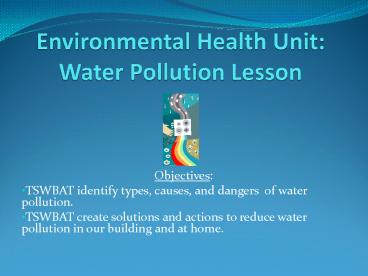Environmental Health Unit: Water Pollution Lesson PowerPoint PPT Presentation
1 / 11
Title: Environmental Health Unit: Water Pollution Lesson
1
Environmental Health UnitWater Pollution Lesson
- Objectives
- TSWBAT identify types, causes, and dangers of
water pollution. - TSWBAT create solutions and actions to reduce
water pollution in our building and at home.
2
Water Pollution
Water covers over 70 of the Earth's surface and
is a very important resource for people and the
environment. Water pollution affects drinking
water, rivers, lakes and oceans all over the
world. This consequently harms human health and
the natural environment. Today you will find
out more about water pollution and what you can
do to prevent it.
3
Types of Pollution
- Can come from a number of different sources
- Single source (oil spill) point-source
pollution - Many sources nonpoint-source pollution
- Most affect the immediate area surrounding the
source. - May affect the environment hundreds of miles away
from the source (nuclear waste) transboundary
pollution.
4
Causes of Pollution
- Sewage wastewater
- Domestic households, industrial agricultural
practices produce wastewater that can cause
pollution of many lakes rivers. - Marine dumping (in parenthesis is how long is
takes for that item to degrade) - Cardboard (2 wks.)
- Newspaper (6 wks.)
- Photodegradable packaging (6 wks.)
- Foam (50 yrs.)
- Styrofoam (80 yrs.)
- Aluminum (200 yrs.)
- Plastic packaging (400 yrs.)Glass (???)
5
Causes of Pollution
- Atmospheric deposition
- Acid rain
- Radioactive waste
- Nuclear waste is produced from industrial,
medical scientific processes that use
radioactive material. - Nuclear waste can have detrimental effects on
marine habitats. - Underground storage leaks
- Over time the steel corrodes and causes leakages,
affecting surrounding soil and groundwater.
6
Causes of Pollution
- Global warming
- An increase in water temperature can result in
the death of many aquatic organisms and disrupt
many marine habitats - Eutrophication
- When the environment becomes enriched with
nutrients. This can be a problem in marine
habitats such as lakes as it can cause algae
blooms. - Fertilizers are often used in farming, sometimes
these fertilizers run-off into nearby water
causing an increase in nutrient levels.
- Industrial waste
- Asbestos, Lead, Mercury, Nitrates, Phosphates,
Sulphur, Oils, Petrochemicals - Oil pollution
- Oceans are polluted by oil on a daily basis from
oil spills, routine shipping, run-offs dumping. - Oil spills make up 12 of the oil that enters the
ocean. The rest comes from shipping travel,
drains dumping.
7
Great Garbage Patch
- THIS IS WHAT HAPPENS WHEN YOU LITTER
- What do you think???
8
Dangers of Pollution
- Virtually all types of water pollution are
harmful to the health of humans and animals. - Water pollution may not damage our health
immediately but can be harmful after long term
exposure.
9
Preventing Pollution
- Conserve water
- turn off the tap when running water is not
necessary - helps prevent water shortages reduces amount of
water needing treatment - Be careful about what you throw down your sink or
toilet. - Don't throw paints, oils or other forms of litter
down the drain. - Use environmentally household products
- Dont overuse pesticides and fertilizers
- This will prevent runoffs of the material into
nearby water sources. - Plants in your garden prevent fertilizer,
pesticides contaminated water from running off
into nearby water sources. - Don't throw litter into rivers, lakes or oceans.
- Help clean up any litter you see on beaches or in
rivers and lakes, make sure it is safe to collect
the litter and put it in a nearby bin.
10
Treating Pollution
- Industrial
- Sewage goes through a number of chambers and
chemical processes to reduce the amount and
toxicity of the waste. - Septic Tanks
- Septic tanks treat sewage at the place where it
is located, rather than transporting the waste
through a treatment plant or sewage system. - Denitrification
- Used to prevent the leaching of nitrates in soil
- stops any ground water from being contaminated
with nutrients. - Ozone Wastewater
- Oxidizes substances (such as iron and sulphur) so
that they can be filtered out of the solution. - There are no nasty odors or residues produced
from the treatment. - Ozone converts back into oxygen quickly, and
leaves no trace once it has been used.
11
NOW ITS YOUR TURN!
- Complete the worksheet for class credit.
- Hand the completed worksheet to Mr. Schreiber by
the end of class today or at the beginning of the
next class meeting.

